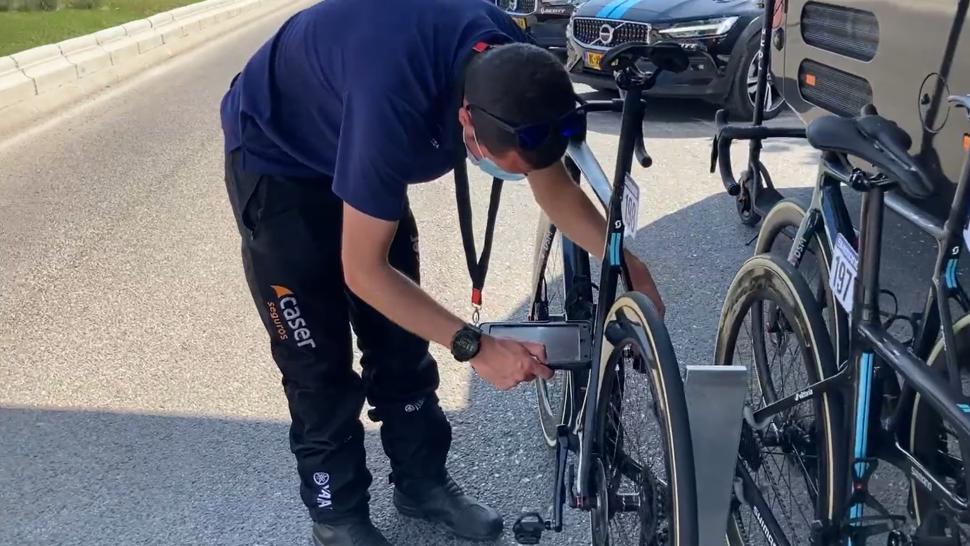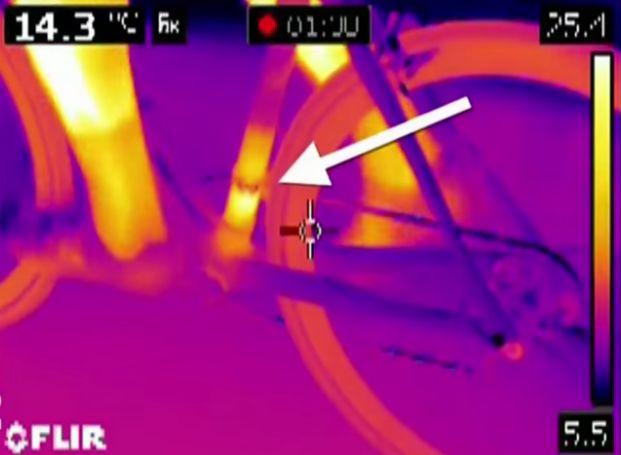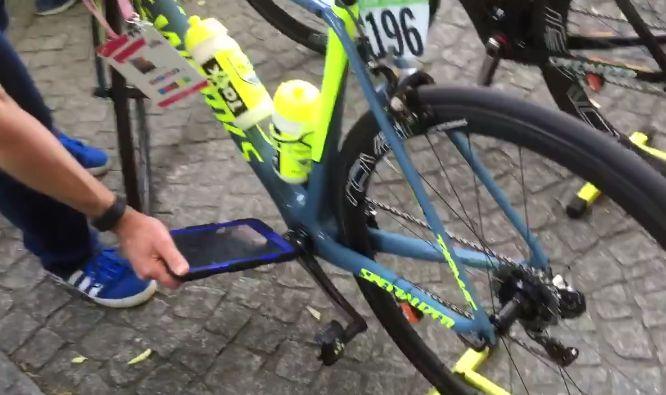- News
- Reviews
- Bikes
- Accessories
- Accessories - misc
- Computer mounts
- Bags
- Bar ends
- Bike bags & cases
- Bottle cages
- Bottles
- Cameras
- Car racks
- Child seats
- Computers
- Glasses
- GPS units
- Helmets
- Lights - front
- Lights - rear
- Lights - sets
- Locks
- Mirrors
- Mudguards
- Racks
- Pumps & CO2 inflators
- Puncture kits
- Reflectives
- Smart watches
- Stands and racks
- Trailers
- Clothing
- Components
- Bar tape & grips
- Bottom brackets
- Brake & gear cables
- Brake & STI levers
- Brake pads & spares
- Brakes
- Cassettes & freewheels
- Chains
- Chainsets & chainrings
- Derailleurs - front
- Derailleurs - rear
- Forks
- Gear levers & shifters
- Groupsets
- Handlebars & extensions
- Headsets
- Hubs
- Inner tubes
- Pedals
- Quick releases & skewers
- Saddles
- Seatposts
- Stems
- Wheels
- Tyres
- Health, fitness and nutrition
- Tools and workshop
- Miscellaneous
- Cross country mountain bikes
- Tubeless valves
- Buyers Guides
- Features
- Forum
- Recommends
- Podcast
feature
 Vuelta motor doping check (@lavuelta/Twitter)
Vuelta motor doping check (@lavuelta/Twitter)A brief history of motor doping in cycling, from the pro peloton to amateur hill climbs
Ah, motor doping. Cycling's most 21st century form of cheating was put back in the spotlight during the Vuelta a España after retired pro Jérôme Pineau made headlines by claiming Jumbo-Visma's success, notably Sepp Kuss' Tourmalet performance, was a result of nefarious mechanical means.
Pineau — who rode for Quick-Step for five seasons and won a Giro d'Italia stage during his 16-year professional career, and has since been criticised for his own behaviour as a team boss — claimed Kuss easily dispatched top riders "who are not losers" and had ridden away at the 2022 Tour de France "for ten seconds without pedalling".
"We see the images… I'm not talking about doping, but about something much worse. Mechanical doping? Yes, mechanical," he said on a French podcast, the unevidenced accusations quickly shut down and rubbished by the Dutch team and many within the cycling world.
Mechanical doping, motor doping — whatever you want to call it is, of course, nothing new, with whispers dating back to the noughties of pro riders finding not-so-legal ways to make their machines faster.
> Mechanical doping: All you need to know about concealed motors
The advance of e-bike technology has only heightened suspicion and the UCI now regularly tests for hidden motors alongside tests for more conventional, pharmaceutical, forms of cheating.
In fact, all 997 Tour de France tests came back negative at this year's edition of the race, leading the UCI to confidently assert it is "impossible" to get away with a hidden motor.
In the never-ending hunt for those tempted to cheat, a UCI Technical Commissaire patrolled the team paddock to test bikes using magnetic tablets before stages, with post-stage backscatter or transmission X-ray tests also carried out on the stage winner's bikes, the yellow jersey rider, as well as the six other riders required to go for an anti-doping test, "selected at random or who might give rise to suspicion".
But who's actually been caught?
Femke Van den Driessche
Former Belgian cyclocross rider Femke Van den Driessche remains the biggest name, and only top-tier professional, to be caught mechanically doping. In 2016, the UCI banned her for six years and handed out a 20,000 Swiss Francs fine following the discovery of a concealed motor in a bike prepared for her at the World Championships in Zolder.
The UCI confirmed the motor concerned was a Vivax, operated by a Bluetooth switch concealed under the bar tape, detected using magnetic resonance testing technology deployed for the first time that year.
Van den Driessche claimed the bike was a friend's and had been prepared for her in error, but ultimately chose not to defend herself at the subsequent disciplinary hearing and was stripped of her U23 national and European titles.
Rumours and conspiracy
No other top-level rider may have been caught, but that hasn't stopped the whispers, gossip and accusations wildly spreading over the internet, a sure-fire social media favourite every time there is a crash and a rider's rear wheel keeps spinning...
And it's not just Jumbo who've fallen foul of suspicion. At the 2014 Vuelta it was Ryder Hesjedal on the receiving end. The Canadian laughed of the accusations as "ridiculous", while our video editor Liam explained why the 2012 Giro winner is almost certainly right. In short, don't spout online every time you see a crashed rider's wheel spinning.
But it wouldn't be a 'motor doping conspiracy' without a mention of Spartacus himself — Fabian Cancellara. Are there any cold, hard facts behind accusations the Swiss powerhouse used a motor to propel his legendary attacks? Absolutely not. Has that stopped some, including ex-pro Phil Gaimon, accusing him? You bet it hasn't...
Cancellara has always strenuously denied the accusations, notably from some sections of the Belgian cycling community after his famous Tom Boonen-toppling attack on the Muur at Flanders in 2010, but as we said, there is no evidence, just internet whispers.
Fabian Cancellara🇨🇭wins the 2010 Tour of Flanders.
2nd - Tom Boonen 🇧🇪
3rd - Philippe Gilbert 🇧🇪#RVV20 pic.twitter.com/u5BdTBU4BM— Pro Cycling Memories (@ClipsCycling) October 17, 2020
But what about in the little leagues?
There are far more cases when we drop down a few rungs of the cycling ladder as unsurprisingly the lack of official UCI checks, and absence of attention from worldwide media and fans enables a minority of corner-cutting riders to cheat, meaning every so often we're blessed with an amateur motor doping tale.
Most recently was the somewhat amusing case from a hill climb in the Ardèche where a 73-year-old finished in 16th place, an impressive three minutes down on the fastest time over the 10km course, only for officials to find a hidden motor in his bike's hub.
Also in France, in 2018, a Cat-3 racer was slapped with a five-year ban after being found to have a hidden motor at the Grand Prix de Saint-Michel-de-Double. Over the border, in Italy, a year later two amateur riders fled a gran fondo before Carabinieri officers arrived. They'd been accused by other participants and refused to have their bikes checked by event officials.
It's not just the pros who get accused either. The winner of the iconic 2022 Maratona dles Dolomites, Stefano Stangi, came out with a statement saying he is not "a fool to cheat on live TV" and Italy is "a country of envious people" after being accused of using a motor to win the mountainous event in July 2022.
Closer to home
While there is yet to be a high-profile case in the UK, in 2016 a to-the-point website called Doped Bikes launched purporting to sell motors specifically designed to be hidden within bikes during races... only to later reveal it was, in fact, a ‘honeypot’ operation aimed at finding out who was prepared to cheat.
> People behind motor doping website reveal it was a honeypot operation
Founders Moreno Grazioli and Roberto Bassi said they were part of a "group of concerned racers and industry insiders" who wanted to "find out who was prepared to cheat our sport".
The pair alleged they had been contacted by an unnamed "UK team boss". No further detail was ever given.
So that's that, a brief look at motor doping in the sport we love. Until the next 'mysteriously' spinning wheel or grassroots accusation...
Dan is the road.cc news editor and joined in 2020 having previously written about nearly every other sport under the sun for the Express, and the weird and wonderful world of non-league football for The Non-League Paper. Dan has been at road.cc for four years and mainly writes news and tech articles as well as the occasional feature. He has hopefully kept you entertained on the live blog too.
Never fast enough to take things on the bike too seriously, when he's not working you'll find him exploring the south of England by two wheels at a leisurely weekend pace, or enjoying his favourite Scottish roads when visiting family. Sometimes he'll even load up the bags and ride up the whole way, he's a bit strange like that.
Latest Comments
- Paul J 2 min 1 sec ago
I think that changed last year. There was a British Cycling National Gravel Championship race held - co-hosted with 1 of the Raiders Gravel days in...
- Tom_77 34 min 58 sec ago
Typically you will signs like this one.
- chrisonabike 40 min 52 sec ago
However, the highway code revisions now provide more detail and the cyclist overtaking picture has been updated. e.g.:...
- eburtthebike 1 hour 28 min ago
And they were right. It says something about our society that people are prepared to put so much money and effort into opposing something as...
- stonojnr 2 hours 31 min ago
Could make a crass joke about how youre only supposed to flip pancakes today, but i wont...
- Mr Anderson 3 hours 6 min ago
I wouldn't worry too much about the locks being picked, in nearly all cases of bike theft, those Ninja moped gangs, the only things they can pick...
- brooksby 3 hours 24 min ago
They want to pick on The Others in general, rather than a specific group. Immigrants can hate Others just as much as Nigel Farage does.
- don simon fbpe 3 hours 28 min ago
There's no doubting how bad the sport must have been when a banker feels moral enough to criticise...!




Add new comment
5 comments
You look at the eBike industry and the massive heavy batteries and motors, then look at the Pro peleton with their 6-7Kg bikes. Where the heck are these motors and batteries going to get hidden? The battery on my wife's eBike weighs 2.5Kg and generates max 250w for "up to" 50k. Well useful on a 190km stage, not. This is a massive herring rouge. If the eBike industry could build a sub-8kg eBike that provided 250W for 190km, we'd all be riding them. Reality is they don't exist and the penalty of dragging the motor and battery around for a quick shot up 1 climb far outweighs any potential benefit.
While I'm not suggesting motor doping is actually going on, you're thinking too big (literally) - in the pro peleton, theoretically they would only need sufficient assistance to make a marginal gain - e.g. a relatively short extra boost to launch a decisive move on the hardest slopes .
What if a rider gets a convenient mechanical close to the foot of a climb, swaps their bike for one with a motor, rides it over the climb and down the descent (where the extra weight might actually even be an advantage) then on the valley floor swaps it back for their #1 bike, now "repaired"? I don't actually believe motor doping is taking place on the World Tour, but that would certainly be one way of overcoming the weight problem and possibly even of avoiding the scrutineers (I don't know if they check all the bikes a winner rode during a stage or just the one they came home on).
A classic piece of flawed logic; a more correct conclusion might be "it is impossible to get away with a hidden motor that would be detectable with the tests we are using"
And: maybe none of the riders happened to be motor doping this year, so there was nothing to detect anyway.